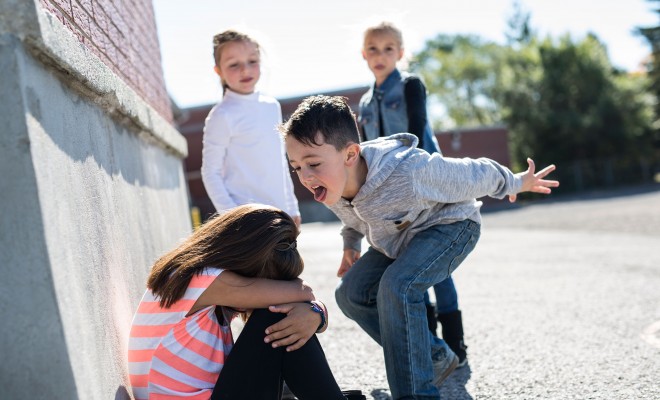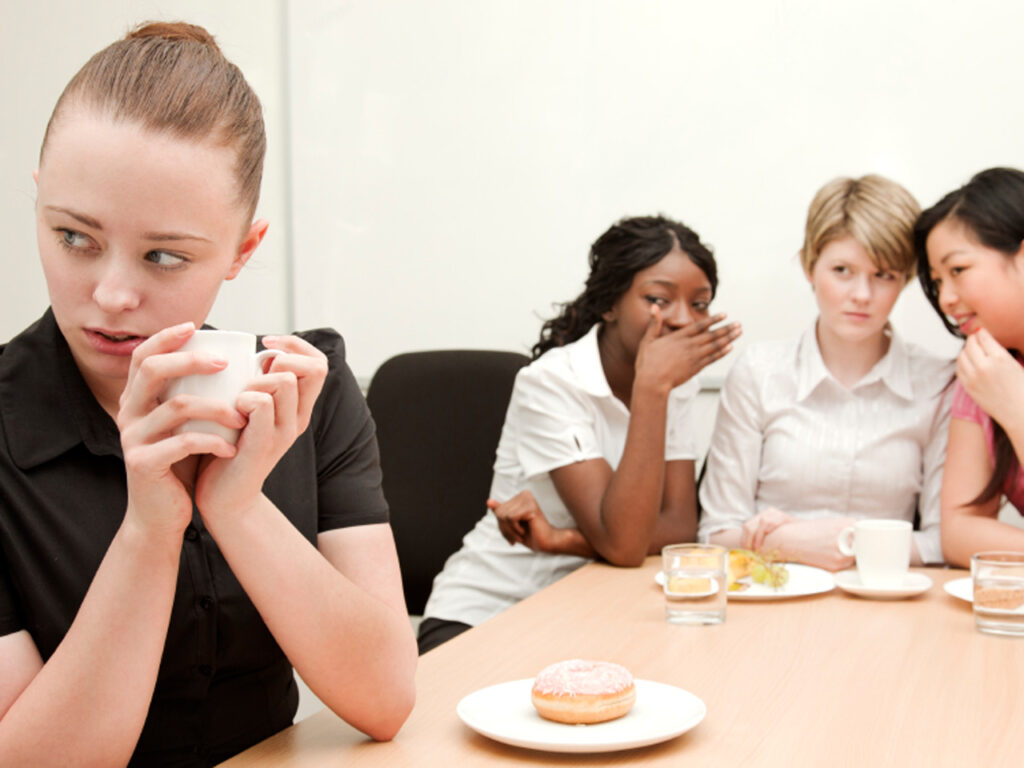
Life as a parent is filled with many challenges, but helping a child to deal with bullying is a heart-breaking ordeal; a task that can be complex, drawn out and negatively impactful in the long term. A very natural primal urge to physically intervene battles against a culturally- learned civil restraint – hostility versus diplomacy. As bad and all as visible physical bullying is, subtle unseen attacks that can, for a long time, go unnoticed are just as sinister and present another layer of difficulties for parents to deal with.
As a martial arts gym with a large cohort of school-going members, we here at SBG Cork are no strangers to the subject of bullying – both the physical and non-physical variations. In our recently launched weekly podcast – “The Fight Coach, the Psychotherapist and the Gym Momma” – we dedicated an episode to this very topic, using our combined experiences to discuss the nuances of the subject and to present our 5-step process for resolving a case of bullying with your child. This blog post is a supplement to that podcast and we hope the information presented resonates with any parent who has gone through or is currently going through similar challenges. If you know of someone who could do with this information, please share this page with them, or invite them to listen to episode 001 of our podcast which is available for download from all podcast subscriptions services.
What is Bullying?

I’m sure you know the answer to this question only too well. However, it is important to be clear and exhaustive in listing out the behaviours and variations of bullying so that we can help our children to understand exactly where they should draw the line in their social interactions. It’s common for a child experiencing bullying to simply not know that they are being mistreated. A child lacking in self assurance might just believe that being treated meanly is normal and their acceptance of subtle forms of bullying may chip away as their self esteem for years. It’s up to us, as parents, to instill a strong sense of self worth in our children and a well developed awareness of what being respected by their peers looks, sounds and feels like. With this in mind, let’s list the variations of bullying:
- Physical: Any hitting, pushing, or threatening postures that cause bodily harm
- Name calling: Teasing that goes too far (e.g. when the target no longer finds it funny)
- Isolating: When groups exclude someone from activities or social circles
- Gossip & rumours: Sometimes referred to a relational bullying where a bully looks to undermine a target’s social standing.
- Sexual bullying: As children develop, inappropriate advances can be an issue
- Prejudicial bullying: Any form of negative treatment due to difference (race, gender, sexuality, family name, neighbourhood, size, disability etc)
- Cyber-bullying: When the above continues on social media
How confident are you that your child is aware of and understands all these types of bullying? Is it possible that your child would ‘put up with’ one or more of these behaviours from their ‘friends’? Are you confident in their ability to know when friendly banter crosses the line? A clear, confident knowledge of this is one of the best tools you can arm your child with in the battle against preventing bullying.
The effects of bullying
Sometimes, the effects of bullying can be very obvious. Bruises, black eyes and bloody noses are hard to miss and if your child experiences an acute traumatic experience (either emotional or physical), it will no doubt be very clear. This, of course, is very serious and needs to be dealt with efficiently.
Non physical or subtle and chronic effects, on the other hand, are by their very nature, hard to spot. If a child doesn’t burst into tears as soon as they come in the door from school, then they must be perfectly fine, right? Well, not necessarily. If their confidence is slowly being eroded over years of social isolation, inappropriate sexual advances, gossip or social media trolling, the effect might not be apparent – even to the child themselves. So if the injury is imperceptible, then what harm could it possibly do? In some cases, a child may learn to adapt or cope and in the long run, they may become resilient enough for it not to affect them at all. In others, the effects may bubble under the surface for years and end up surfacing with anxiety or depressions at a much later stage. In rare cases, extreme bullying can lead to tragic ends, as dramatised in tv shows like “14 Reasons Why”.
While the vast majority of bullying cases are mild and enforce modest long term effects on children as they grow older, we must be careful not to trivialise the topic. To the average person looking at someone who suffers with OCD or a phobia of spiders for example, their irrational fear or obsession seems silly. However, we know that fear, for the person suffering, is very real and oftentimes, severely debilitating. To a grown adult, a 6 years old calling their classmate “four eyes” or pinching them on the arm may seem trivial, but the 6 year old target is no doubt quite upset. For them, that trauma is very real. Let’s flip the script for a second. Let’s say an adult equivalent might be the likes of the Peaky Blinders bossman – Tommy Shelby – giving you a dead-eyed stare, whilst telling you how much money you’re going to hand over this week as part of his protection arrangement. A 6 year old child might just see that as two adults having a friendly chat. They may not realise that one of those adults now needs a change of underwear and a course of counselling.

“Just ignore them” or “Don’t listen, they’re only jealous” are common answers given by parents to children who express their distress. Is this a form of trivialisation? Or perhaps a lack of knowledge of how to deal with the situation? Of course, we can’t cry wolf at every instance of children being mean to one another, but as a parent, where is the line you draw between playing the situation down and leaping into action? Remember, the effect may take years to surface. Just because you can’t see it now, doesn’t mean it’s not happening.
Get involved in the conversation!
We’d like to hear from you over in our Facebook Community Page: “What way were you bullied as a child? Might seem funny now but was terrifying at the time. What effect did it have on you?”
Why do bullies bully?

Answering this question could be an entire book by itself. We see animals in the wild routinely engaging in displays of dominance over their peers. Being mean to each other is part of our DNA and it’s only modern civilisation that has taught us the benefits of cooperation, patience and diplomacy. If we weren’t taught it as children, and conditioned throughout our formative years to continue to be kind and inclusive, we simply wouldn’t know how. Bullying would be how pecking orders were established.
To a certain extent, this is still the case. Not all adults are the picture of civility. Not all our sporting role models display patience and diplomacy. While humans have evolutionarily developed beyond the “Wild Animal” stage, we still have plenty of examples of rams having head butting competitions and peacocks one-upping each other, and children can be confused by the examples set by the adults they bear witness to.
I guess I’m saying that we’re all potentially bullies unless we are taught otherwise. In an ideal world, all children grow out of being bullies. Sadly, we know this is not always the case and some kids are left with their primal need for dominance intact – a need that stays with them into adulthood. That has its own set of circumstances – which is another day’s work. To answer the question: “Why Bullies Bully”, we could list a few reasons as follows:
Bullies:
- Need/want to feel dominance over someone (a victim)
- Need/want to be different/special/more important
- Need to knock others to make themselves feel better
- May be lashing out due to trauma they’ve experienced in their own lives
- May have learned to be aggressive to others from TV shows or older siblings/parents
So why is it important to know this? Well, in the case of younger children who bully, they may just be in need of some direction or require help themselves. Perhaps they are just unaware what they’re doing is bullying. Remember, we’d all be bullies if we didn’t learn otherwise. I’m not for a minute excusing bullying behaviour. Empathy should be a tool to help find a viable solution, not an excuse to roll over and accept bad treatment. However, with younger bullies… it’s more likely the behaviour is correctable, with guidance, and that’s good to know.
In the case of older bullies, who are perhaps beyond saviour. Well, it’s good to know that the target is not to blame. Bully’s bully. So if their target is tempted to feel like they’ve provoked mistreatment or have any culpability in the transaction, we can and should remind them otherwise. Targets of bullying have enough to be upset about without bearing a burden of guilt also.
It’s important to understand where negative influences and poor role models can mold younger bullies also. Don’t forget, EVERY child has the ability to become a bully and we can’t be so presumptuous to think that our own kids don’t have those primal instincts to seek social dominance at times either. Keeping a close eye on who our kids are exposed to as role models is our duty, as parents.
How to spot subtle signs of bullying

In the absence of visible bruises or an explicit declaration from your child that they are experiencing bullying, it can be difficult to spot the signs that something might not be right. It’s common for a child to be embarrassed to speak up. Perhaps they’re scared nobody will believe them or that they will be punished by the bully for “telling”. It might also be that the child doesn’t realise that they are being treated unfairly to begin with (as we talked about earlier in the importance of knowing what bullying actually is).
Here are a few signs that you should learn to recognise:
- Is your child acting out of sorts? Something just not quite right.
- Do they seem anxious? (not sleeping, not eating)
- They don’t want to do things they normally very much enjoy.
- Stomach aches when it’s time to go to school or to an activity?
Of course, these could all be general behaviours of a moody teen but as a parent, you’re best qualified to know when something is a bit more off than usual. Trust in your instinct and if you’re suspicious, then begin to be subtly inquisitive.
A great way to bring a topic like bullying up in conversation is while noticing poor behaviour in a TV program that you’re all watching. For example, you could say “Wow, that was a bit mean, wasn’t it?”…. Use that as an entry to ask “Have you ever seen someone do that in your school?” or “Has anyone ever said that to you?”.
Another method would be to ask their teacher or coach in an activity to watch out for clues or signs during activities. Teachers are often very experienced in dealing with cases of bullying and can be in a position to help get to the bottom of things subtly. In our kids martial arts classes at SBG Cork, we use our “mat chat” time to allow kids to tell stories about their week and if a parent mentions to us that they suspect bullying, we can steer that week’s mat chat to see if we can get all the kids to open up about things that might have happened to them at school. Any clues found can be fed back to the parents to help uncover what may be going on.
If you’re really struggling to open a line of communication and you know in your gut that something is not quite right, then consider reaching out to a counsellor or therapist. Professionals trained in this area are very good at creating an environment where children feel at ease to discuss things openly and assessing if there are more serious stressors at play.
5 step process for resolving a bullying issue
Ok, so now you know there’s something going on and it’s time to take action. While firm action is required, it’s also important to keep a clear head and be aware of all the long term implications of every action here. Both an overreaction or underreaction can be equally detrimental and as a parent, you should absolutely make sure to get through all 5 steps so that you ensure to mitigate any long term effects on your child’s self esteem.
Step 1: Listen Calmly and offer support and reassurance
Before any actions are taken, be sure to reward the bravery of your child for communicating with you. Building a trust with your child to the point where they feel that they can open up to you in times of need is hugely important. Imagine the opposite, where a child bottles up anxiety and stress for years. Nobody should go through that. You want to reward the behaviour you’d like to see repeated. Taking the time to express how proud you are of your child having the courage to ask for help at a time like this is a pivotal opportunity, not to be missed or overlooked.
As a parent, it would be natural at this point to think perhaps your child is being a bit over sensitive or telling tales. Or perhaps you might be upset that your child is being victimised. However, this is not your time. Step 1 is all about reassurance. Give your child the benefit of the doubt and be 100% supportive. If at a later stage, you find they’ve over reacted or are milking it, you can deal with that then.
Step 2: Let someone at the school or club know the situation
Next, you need to build the support team. Wherever the bullying has or is occurring, report the incident to the teacher/coach and engage with whatever bullying procedure they have in place. All schools have their own procedure. It’s likely the report of bullying will be news to the teacher also so it’s important to let them know so that they can implement a system to ensure the safety of your child (either by removing them from a dangerous situation or by separating the bully from the target during activities etc).
If a school or club has a robust bullying policy, they will manage all the necessary steps involved in communicating with the bully and his/her parents. In most cases, this will bring an end to the situation or at the very minimum, reduce the dangers.
Regular communications and updates are essential here also. Teachers have a lot going on in their class schedule so it’s no harm to make sure your child’s predicament is ongoing, if that’s the case.
Step 3: Give your child the tool & tactics to cope
Even with a teacher’s intervention, it’s likely the situation won’t be resolved overnight. Complex issues can take months to resolve and children often share a classroom for years as they progress through the grades together. Having coping mechanisms at this point will empower your child to take control of their own situation. Remember also that they will always face adversity in life. Think of this resolution phase as practice for bigger challenges in adulthood. This is where you help your child to build resilience. Some tactics here could be around deep breathing exercises to deal with anxiety, how to keep a poker face to show a bully that their insults don’t affect you, counting to 10 to dissipate anger etc. Think of how useful these skills will be in years to come as they have to deal with difficult situations in the workplace.
Step 4: Follow through to conclusion; escalate when necessary
Remember your child showed extraordinary bravery to communicate to you that they needed help. Now it’s your turn to have their back when it counts. If for whatever reason, reporting the issue to the teacher didn’t resolve things, then go back again and escalate the matter to the principal’s office. If that doesn’t work, you go higher to the department of education or through legal channels if necessary. Go all the way to a full conclusion, whatever it takes. You don’t stop until you and your child get satisfactory resolution. Your child needs to know that it was worthwhile putting their trust in you. Otherwise, next time, they will just bottle it up and get depressed. Remember, you are building a self assured, confident and resilient child. That doesn’t happen by accident. This is your time to dig in and be as brave as your child was earlier.
Step 5: Rehab your child’s confidence and self esteem
Like any injury, you must work to get back to 100%. An episode of bullying will no doubt have had a toll on your child’s confidence. They may now be firing at 60-70%. If left unchecked, the next incident might bring that to 50% and over time, that can lead towards depression. You want to build the skill of “Bounce-back-ability” and make the return to 100% a habit following any injury to self-esteem. Things that can help here include:
- Ensure your child gets to spend time with friends in a positive, fun environment
- Organise some 1 on 1 time with them (go shopping, go fishing, go to a football match etc), and remind them of how brave they were to work through their issue.
- Get them moving in high energy activities to start releasing endorphins again. Sport is always good for that.
Above all else, DO NOT LET YOUR CHILD WALLOW in the aftermath of an insult to their esteem. Being down can become a habit just like anything else. Help them build the more constructive habit of bouncing back. This will serve them much better in the long run.
IMPORTANT. Doing step 5 without 2, 3 & 4 is not acceptable. That’s just glossing over the issue and enabling the stress to continue long term. You want resolution, not avoidance.
Get involved in the conversation!
So for the listeners out there, if you’re on twitter, I’d like you to take a minute to tweet your opinion on our 5 step process… Was it insightful or useful? Or did we get it all wrong. Make sure you mention us with the handle @FCPGMPodcast and we’ll engage in the conversation with you.
Is Violence ever ok?

In a case where a child’s safety is at risk and there’s no adult nearby to intervene, then of course a child has every right to fight back in self defence. In some cases, a physical bully is deterred by someone who fights back. They’ll typically move on to an easier target next time. However, you must bear in mind that a bully generally picks on those they are already confident they can overpower. If your child does not have experience in a functional martial art, they may just get beaten up badly. “Just punch him back” is not always good advice. You may be putting your child in the way of even more harm and that may compound the insult to self-esteem.
With that in mind, would it not be a good idea to make sure your child has some solid training in a competitive martial art? If they do have to throw a punch, should it not be a strong, well placed one? If they get knocked to the ground, wouldn’t it be great if they knew how to get back up or better yet be able to defend themselves while from the bottom? How much of an advantage would it be if your child didn’t panic in the face of a violent confrontation? How is that even possible? To paraphrase SBG Founder – Matt Thornton – It’s possible through “a healthy relationship with violence” and competition. With good Brazilian Jiu Jitsu, Kickboxing and MMA training (all functional martial arts), kids (and adults) can learn to overcome the panic that causes most people to freeze at the sight of aggression. With graduated increments and a controlled desensitivity to uncomfortable situations, anyone can improve their ability to deal with physical confrontation. They learn to become comfortable with the uncomfortable.
Of course, it’s not a quick fix. Becoming proficient takes years of consistent effort. However, from our experience, fear is conquered with knowledge and confidence grows with experience. At SBG Cork, our kids classes are run under the Growing Gorillas system. This is a syllabus that tracks childhood development from preschool right up to secondary school and at every stage along the way, we teach not only the level of martial arts skill that’s appropriate to their age, but also the life skills that help them at whatever stage of life they’re at. Bully Busting is a massive part of that process throughout.
In summary
Overall, dealing with childhood bullying is a complex situation that requires vigilance, compassion and follow through. It’s important that your child is aware of what constitutes bullying – both so that they know what level of respect/courtesy is normal to receive and what’s unacceptable to put up with, as well as ensuring they don’t step over the bully line themselves. Knowing how to spot the signs of subtle bullying is an absolute must and sometimes you’ll need to get creative to figure out the clues of the source of anxiety.
Hopefully our 5 step process for resolving a bullying issue outlined above is something that will help you or someone you know that’s dealing with bullying right now. We’re always available at SBG Cork to chat more about particular circumstances or cases. Be sure to contact us with your concerns.
In the meantime, if you want to give your child the best advantage when it comes to physical ability in tried and tested functional martial arts, our Growing Gorillas program is something you should consider.
Call 021 4215007, email [email protected] or just drop by Unit 31, Northpoint Business Park, New Mallow Road, Cork and we’ll give you a tour of our facilities.
For help or advice on more extreme cases of trauma, anxiety or stress management, James White of API Clinics is available by appointment at SBG Cork. Visit www.APIClinics.com
If you found this article useful, please share it